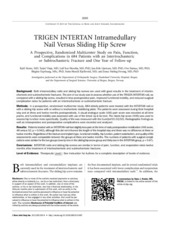| dc.description.abstract | Background: Both intramedullary nails and sliding hip screws are used with good results in the treatment of intertrochanteric and subtrochanteric fractures. The aim of our study was to assess whether use of the TRIGEN INTERTAN nail, as compared with a sliding hip screw, resulted in less postoperative pain, improved functional mobility, and reduced surgical complication rates for patients with an intertrochanteric or subtrochanteric fracture. Methods: In a prospective, randomized multicenter study, 684 elderly patients were treated with the INTERTAN nail or with a sliding hip screw with or without a trochanteric stabilizing plate. The patients were assessed during their hospital stay and at three and twelve months postoperatively. A visual analogue scale (VAS) pain score was recorded at all time points, and functional mobility was assessed with use of the timed Up & Go test. The Harris hip score (HHS) was used to assess hip function more specifically. Quality of life was measured with the EuroQol-5D (EQ-5D). Radiographic findings as well as intraoperative and postoperative complications were recorded and analyzed. Results: Patients treated with an INTERTAN nail had slightly less pain at the time of early postoperative mobilization (VAS score, 48 versus 52; p = 0.042), although this did not influence the length of the hospital stay and there was no difference at three or twelve months. Regardless of the fracture and implant type, functional mobility, hip function, patient satisfaction, and quality-of-life assessments were comparable between the groups at three and twelve months. The numbers of patients with surgical complications were similar for the two groups (twenty-nine in the sliding-hip-screw group and thirty-two in the INTERTAN group, p = 0.67). Conclusions: INTERTAN nails and sliding hip screws are similar in terms of pain, function, and reoperation rates twelve months after treatment of intertrochanteric and subtrochanteric fractures. | en_US |
